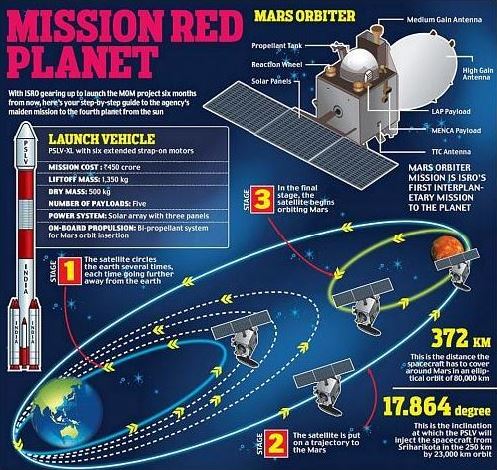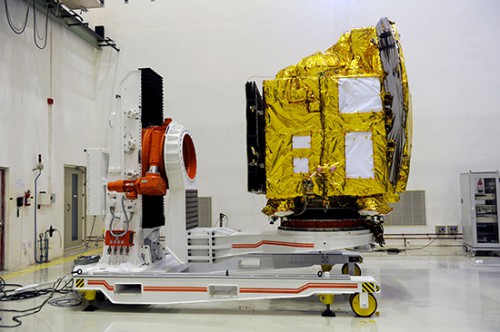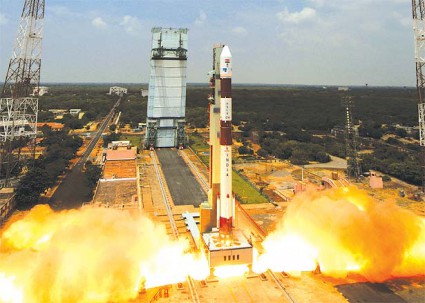
Less than three weeks remain until the scheduled 28 October launch of India’s first mission to Mars, and NASA assured the Indian Space Research Organisation (ISRO) last weekend that the ongoing U.S. government shutdown will not preclude it from providing communications and navigation support. The Mars Orbiter Mission (MOM)—also known as “Mangalyaan” (Hindi for “Mars Craft”)—arrived at the Satish Dhawan Space Centre on the barrier island of Sriharikota, within India’s southern state of Andhra Pradesh, on 3 October and should be in position to begin final pre-launch checkout later this week. It will fly atop the highly reliable Polar Satellite Launch Vehicle (PSLV) and is expected to enter orbit around the Red Planet in September 2014.
The present shutdown of most non-critical U.S. government facilities has resulted in a near-total media blackout from the space agency, with even the successful injection of the Lunar Atmosphere and Dust Environment Explorer (LADEE) spacecraft into orbit around the Moon on Sunday being reported through other sources. However, earlier this year it was announced that the MOM/Mangalyaan mission would utilize the Deep Space Network (DSN) antennas, situated in Spain, California, and Australia, during periods in which the spacecraft is not visible to the Indian Deep Space Network (IDSN). With the current offline status of NASA websites, and with the space agency operating on a skeleton staff, there was understandable concern that the situation might adversely affect MOM/Mangalyaan.

These concerns were allayed in an ISRO press release on Saturday, 5 October. “NASA-JPL authorities have reaffirmed support for the MOM as planned,” ISRO revealed, “and stated that the current U.S. government partial shutdown will not affect the schedule of MOM.” Although the IDSN—situated near Bangalore, India, which currently features 32-meter and 18-meter fully-steerable deep-space antennas—is expected to provide primary navigation and tracking of the mission, the NASA assets will offer additional support during the Indian network’s “non-visible period.”
This is a highly ambitious—and almost unlikely—mission for the world’s second most populous nation, having only received formal approval and a $41 million financial allocation from the Indian government in August 2012. With estimated costs as high as $100 million, the mission unsurprisingly drew criticism last year from those who pointed to India’s power failures and the risk of drought in the aftermath of weak monsoon rains. Quoted by the BBC, one Indian government official bit back at the critics. “If we don’t dare dream big, it would leave us as hewers of wood and drawers of water,” the official declared. “India is today too big to be just living on the fringes of high technology.”
Described as “a technology demonstration project,” MOM/Mangalyaan’s primary task is to prove that India has the technical capability to design, plan, manage, launch, and operate a deep-space mission across the vast gulf to reach the Red Planet. The spacecraft carries a payload of five scientific instruments—the Methane Sensor for Mars (MSM), Mars Colour Camera (MCC), Mars Exospheric Neutral Composition Analyzer (MENCA), Thermal Infrared Spectrometer (TIR), and Lyman-Alpha Photometer (LAP)—and will be dedicated to developing a clearer understanding the morphology, topography, and mineralogy of the Martian surface, the dynamics of its tenuous upper atmosphere, the effects of the solar wind and radiation, and the nature of the planet’s large moon, Phobos.
Liftoff of the mission was scheduled within a month-long Mars “launch window,” which extends from 21 October until 19 November, and after a national committee of experts—including professors from the Indian Institute of Science at Bangalore and the famed Indian aerospace scientist and fluid dynamicist Roddam Narasimha—gave the formal go-ahead, it was announced on 22 September that the flight would begin, weather permitting, on “the first available opportunity” on 28 October. According to Spaceflight Now, the launch window opens at 4:15 p.m. local time (6:45 a.m. EDT). Assembly of the at the Sriharikota launch site began in early August, and the vehicle is expected to be ready for the integration of the MOM/Mangalyaan spacecraft as early as Thursday, 10 October.

Developed and operated by ISRO, the PSLV is one of the most reliable members of India’s fleet of launch vehicles. Standing 44 meters tall, the four-stage rocket has the potential to deliver payloads weighing up to 3,250 kg into low-Earth orbit and up to 1,410 kg into geostationary transfer orbit and is therefore ideally suited to boost the fully-fueled 1,350 kg MOM/Mangalyaan spacecraft aloft. First flown in September 1993, the rocket has completed 24 missions, of which one—ironically the PSLV’s maiden voyage—suffered an attitude-control failure during the separation of its second and third stages, crashing into the Bay of Bengal 700 seconds after liftoff. Another experienced an underperformance of its fourth stage during a September 1997 launch, but every other flight has been flawless.
The MOM/Mangalyaan mission will ride aboard the uprated PSLV-XL, which made its inaugural flight in October 2008, carrying Chandrayaan-1, India’s first spacecraft to visit the Moon. The vehicle will be powered for the first portion of its flight by a single first-stage engine and six strap-on boosters, all of which utilize a solid fuel of hydroxyl-terminated polybutadiene. Although the boosters will burn for just 44 seconds, the first stage will continue to drive the PSLV-XL uphill for the first 4.5 minutes of the mission. The second stage and its single Vikas liquid-fueled engine will take over for 2.5 minutes, followed by the solid-fueled third stage for 83 seconds and lastly the twin liquid-fueled motors of the fourth stage for a little over 7 minutes.
Throughout its history, variants of the PSLV have delivered payloads into orbit on behalf of India, Germany, South Korea, Norway, Italy, Luxembourg, Indonesia, Argentina, Israel, Canada, Japan, the Netherlands, Denmark, Switzerland, Turkey, Algeria, Singapore, Russia, Austria, the United Kingdom, and France. On its most recent launch, on 1 July 2013, it successfully delivered the IRNSS-1A payload into orbit for the Indian Regional Navigational Satellite System.
After the PSLV-XL has placed MOM/Mangalyaan into low-Earth orbit, the spacecraft will execute a series of six thruster firings to expand its orbit to an apogee of 215,000 km and a perigee of 600 km. Its Liquid Apogee Motor (LAM), fueled by monomethyl hydrazine and nitrogen tetroxide, was successfully tested in October 2012 at ISRO’s Liquid Propulsion Systems Centre at Mahendra Giri in Tamil Nadu. It will remain in this highly elliptical orbit for about a month, ahead of a final burn on 27 November to place it onto a trans-Mars trajectory. The spacecraft will cruise through interplanetary space for 10 months, with the LAM burns to enter an elliptical orbit of 500 x 80,000 km around the Red Planet currently scheduled for 21 September 2014.
India is still riding on the success of Chandrayaan-1, its first mission to the Moon, in 2008, which returned valuable data about the presence of large deposits of liquid water in the lunar interior. India is presently working toward a multi-faceted Chandrayaan-2, which is scheduled to launch a lunar orbiter, lander, and roving vehicle sometime in 2015, and if the MOM/Mangalyaan mission proves successful, it will make ISRO the fourth national space agency—after Roscosmos, NASA, and the European Space Agency (ESA)—to fly its own mission to the Red Planet.
Want to keep up-to-date with all things space? Be sure to “Like” AmericaSpace on Facebook and follow us on Twitter: @AmericaSpace




One Comment
One Ping
Pingback:In Aftermath of Cyclone Phailin, India Monitors the Weather Ahead of First Mars Mission « AmericaSpace